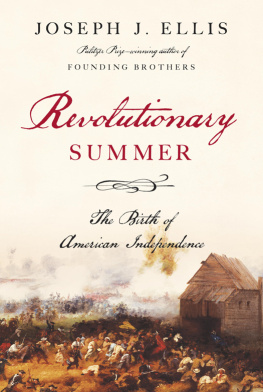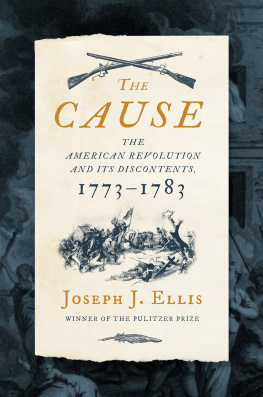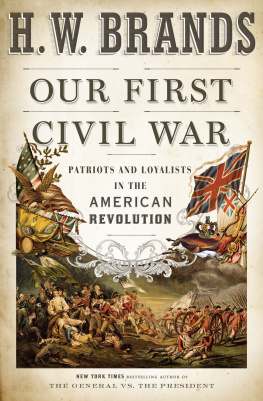ACKNOWLEDGMENTS
The chronological terrain over which this story moves is highly contested ground, littered with the dead bodies of historians who have preceded me. My effort to offer a fresh interpretation that brings together the political and military sides of the story has been aided by several distinguished historians who have scouted the same terrain and laid down their markers on the trail.
Five historians read all or most of the book in manuscript form and saved me from multiple blunders, but they are in no sense responsible for those that remain: Edmund S. Morgan, the acknowledged dean of early American historians, my mentor and friend for nearly fifty years; Gordon Wood, the reigning scholarly expert on the American Revolution and early republic; Pauline Maier, the leading scholar on the drafting of the Declaration of Independence, whose marginal comments (e.g., Joe, you cant say that!) could not be ignored; Edward Lengel, editor in chief of the Washington Papers and ranking expert on Washington as commander in chief; and Robert Dalzell, that wise man of Williams College, who moves across great patches of the American past with such easy erudition.
Stephen Smith, editor of the Washington Examiner, is my long-standing critical eye in that crucial junction where substance meets style, a genius at noticing where a phrase, sentence, or paragraph does not quite say what it wants to say.
Dan Frank of Random House came aboard as editor of this book and ushered it through the corridors of power with an impressive combination of wisdom and grace. His able assistant, Jill Verrillo, never put my calls on hold.
Paul Staiti, my colleague at Mount Holyoke and one of the leading historians of the art and architecture of revolutionary America, helped with the selection of illustrations. Jeffrey Ward did a masterful job of making the maps both depict the battles and fit the text.
Ike Williams, my agent, handled all the contractual niceties, made sure the people at Knopf were paying attention, and routinely brought me back from the eighteenth century with gossip about the Celtics, Patriots, and Red Sox.
Linda Chesky Fernandes, my assistant, did not do any of the research, but she did just about everything else, to include deciphering my scrawl, compensating for my technological incompetence, balancing my mood swings, and kissing me on the cheek.
My wife, Ellen Wilkins Ellis, did not edit my writing, but she did edit my psyche. I have a strong suspicion that this made a huge difference.
Most of the writing was done in longhand in my study at Amherst, surrounded by a feisty Jack Russell terrier, an earnest Labradoodle, and a very brave cat.
This book is dedicated to Ashbel Green, my editor at Knopf for twenty years and six books. Ash passed away just as I was finishing the manuscript. We always argued over adverbs, semicolons, and subtitles, conversations that invariably drifted to the pathetic state of his beloved Cleveland Indians. Ash was a legend in his own time at Knopf, the essence of editorial integrity, a dour Presbyterian with an aristocratic sense of honor. We shall not see his likes again.
JOSEPH J. ELLIS
Amherst, Massachusetts
ALSO BY JOSEPH J. ELLIS
First Family: Abigail and John Adams
American Creation: Triumphs and Tragedies at the Founding of the Republic
His Excellency: George Washington
Founding Brothers: The Revolutionary Generation
American Sphinx: The Character of Thomas Jefferson
Passionate Sage: The Character and Legacy of John Adams
After the Revolution: Profiles of Early American Culture
School for Soldiers: West Point and the Profession of Arms
(with Robert Moore)
The New England Mind in Translation
A Note About the Author
Joseph J. Ellis is the Pulitzer Prize-winning author of Founding Brothers. His portrait of Thomas Jefferson, American Sphinx, won the National Book Award. He is the Ford Foundation Professor of History Emeritus at Mount Holyoke College. He lives in Amherst, Massachusetts, with his wife and their youngest son.
Other titles by Joseph J. Ellis available in eBook format
American Creation 978-0-307-26774-0
American Sphinx 978-0-375-72746-7
First Family 978-0-307-59431-0
Founding Brothers 978-1-4000-7768-7
His Excellency 978-1-4000-4376-7
Visit: www.josephellishistorian.com
Like: www.facebook.com/pages/Joseph-J-Ellis/152923398076184
For more information, please visit www.aaknopf.com

1

Prudence Dictates
Is it not a saying of Moses, Who am I, that I should go in and out before this great People? When I consider the great events which are passed, and those greater which are rapidly advancing, and that I may have been instrumental in touching some Springs, and turning some small Wheels, which have had and will have such Effects, I feel an Awe upon my Mind, which is not easily described.
JOHN ADAMS TO ABIGAIL ADAMS , May 17, 1776
B y the spring of 1776, British and American troops had been killing each other at a robust rate for a full year. While the engagements at Lexington and Concord had been mere skirmishes, the battle at Bunker Hill had been a bloodbath, especially for the British, who lost more than 1,000 men, nearly half their attack force. The American dead numbered in the hundreds, a figure inflated by the fact that all the wounded left on the field were dispatched with bayonets by British execution squads enraged at the loss of so many of their comrades. Back in London, one retired officer was heard to say that with a few more victories like this, the British Army would be annihilated.
Then, for the next nine months, a congregation of militia units totaling 20,000 troops under the command of General George Washington bottled up a British garrison of 7,000 troops under General
In addition to these major engagements, the British navy had made several raids on the coastal towns of New England, and an ill-fated expedition of 1,000 American troops led by Benedict Arnold, after hacking its way through the Maine wilderness in the dead of winter, suffered a crushing defeat in the attempt to capture the British stronghold at Quebec. Though most of the military action was restricted to New England and Canada, no reasonable witness could possibly deny that the war for American independence, not yet called the American Revolution, had begun.
But if you widen the lens to include the Continental Congress in Philadelphia, the picture becomes quite blurry and downright strange. For despite the mounting carnage, the official position of the congress remained abiding
While everyone in the Continental Congress knew this was a fanciful fabrication, it was an utterly essential fiction that preserved the link between the colonies and the crown and thereby held open the possibility of reconciliation.
One might argue that those wounded American boys who were bayoneted to death on
In the meantime, however, during the final months of 1775, the military and political sides of the American Revolution were not aligned. There were, in effect, two embodiments of American resistance to British imperialism, two epicenters representing the American response to Parliaments presumption of sovereignty. The Continental Army, under Washingtons command, regarded American independence as a foregone conclusion, indeed the only justification for its existence. The Continental Congress regarded American independence as a last resort, and moderate members under the leadership of John Dickinson from Pennsylvania continued to describe it as a suicidal act to be avoided at almost any cost.








 1
1